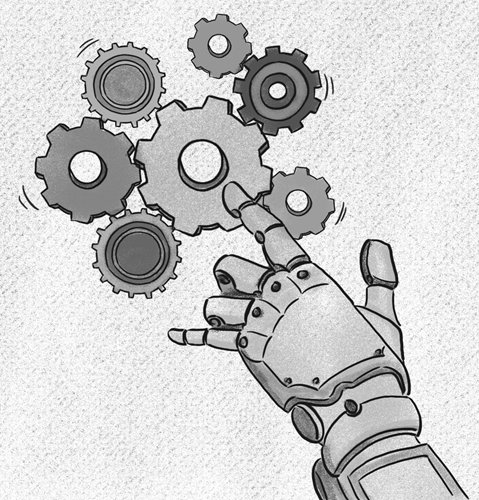HOME >> BUSINESS
Sufficient confidence required for China to ratchet up intelligent manufacturing
By Yao Yang Source:Global Times Published: 2019/9/26 19:58:41

Illustration: Xia Qing/GT
In the past 10 years, the added value of the secondary sector, which includes manufacturing, construction and transportation, take up less share of China's GDP, dropping significantly from 48 percent to 40 percent.
This change is in line with the evolution of industrialization in countries that have successfully achieved industrialization. The proportion of industrial added value first rises and then falls after reaching the 45 to 50 percent range. The decline process is generally referred to as "de-industrialization."
There are some misunderstandings about de-industrialization in China. One of them is that China no longer needs to develop manufacturing, but to develop the service industry. This notion fails to understand the key role of manufacturing in the long-term growth of a country's economy.
A lower percentage does not necessarily mean a decline in the absolute value or quality. History has shown that countries or regions that successfully sidestepped the middle-income trap also show that their productivity of manufacturing sectors are still ahead of other industries as the engine for economic growth after the start of de-industrialization. Manufacturing sectors can play such an important role mainly attributed to two characteristics.
First, the technological progress rate of the manufacturing sectors is much higher than that of the service industry. Second, the products of the manufacturing industry can be traded across borders. A country with a weak manufacturing industry and a great number of imports must rely on the service industry.
However, the service industry's technological progress rate is low and cannot be promoted. As a result, the country's growth will be hindered. Germany's manufacturing industry is developed, with a large trade surplus, and its economic growth also tops among EU countries. By contrast, the countries with weak manufacturing in southern Europe are dragged down by the huge trade deficit and have stayed sluggish after the European debt crisis.
Since the founding of the People's Republic of China, manufacturing has been regarded as the basis of the country. In the past 70 years, China's industrialization has experienced three waves. The latest one was the decade after entering the WTO in 2001. Driven by the export processing industry, China's industrialization during this period has greatly sped up. At present, China is the only country that covers all the industries in the United Nation's industry classification system.
How to keep upgrading the manufacturing and enhancing competitiveness in a de-industrialization trend is a challenge for China's economic growth. For people who believe that China has not yet entered de-industrialization, China has no space for a all-round industrial production expansion. On the one hand, domestic labor prices have risen, and the soaring costs have squeezed the profit margins of low-end manufacturing. On the other hand, with the international pressure on emission reductions building up, industrialization based on fossil fuels has less leeway. The only option before China is to take the path of high-quality economic growth, by boosting intelligence manufacturing, productivity and product competitiveness.
However, taking the path of high-quality development does not mean that high technology is the only choice for every enterprise. Now, "high-tech anxiety" is prevalent among companies, and companies believe that they will have no bright future if they don't apply these technologies. In fact, technology does not have distinctions of high and low, only efficient and inefficient. Efficient technology can improve the competitiveness and profitability of enterprises, while inefficient technology does the opposite. No matter how cutting-edge technology is, it should eventually be transformed into corporate profits.
After the three waves of industrialization, China has gained comprehensive scientific and technological progress in various fields. In areas such as telecommunications, space technology and artificial intelligence, China has entered the world's top tier. In other fields, China is still catching up, which is precisely where China's strengths lie. Since the catching-up path is clear-cut, costs can be saved.
After more than 20 years of experience in the export processing industry, China's exports have returned to machinery manufacturing. This is not a simple return, but a return based on intelligent manufacturing. A large number of potential champion enterprises have already emerged in China. They have fully realized intelligent manufacturing and can manufacture internationally competitive products.
Rome was not built in a day, and the transformation into intelligent manufacturing cannot be done overnight. China needs to be patient, giving enterprises space and time to transform and upgrade. In 10 years, China is expected to enter the world's first-rate rankings in intelligent manufacturing.
The author is director of the China Center for Economic Research at Peking University. bizopinion@globaltimes.com.cn
Posted in: INSIDER'S EYE